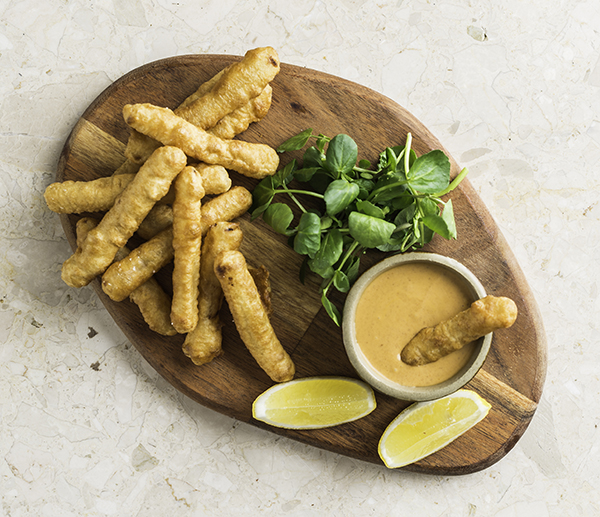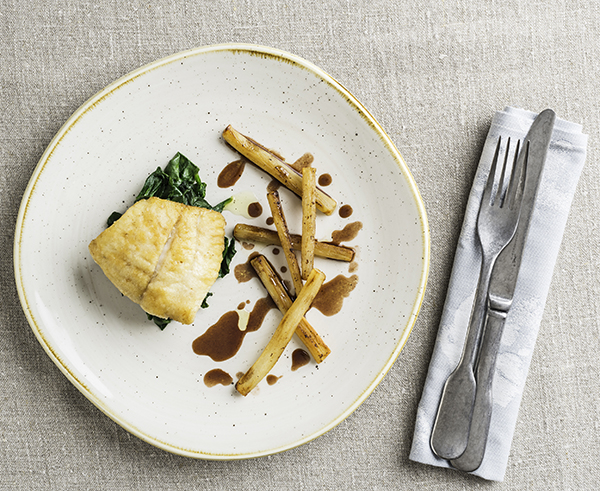Home-grown harvest: salsify
It takes a bit of a stir for a vegetable to make the national newspapers, but when a major supermarket starts stocking an unusual vegetable, that is exactly what happens.
This is something chefs have known for a long time and salsify really is a popular ingredient, especially in higher-end restaurants. Bringing the product to a wider public through the supermarkets can only increase that popularity.
Salsify is a member of the daisy family and has grass-like leaves that grow up to 120cm tall. There are two types, one white and one black. The white variety looks more like a heritage carrot or thin parsnip, is fairly short at 5cm-12cm and is noticeably tapered with hair-like rootlets protruding from the main root. Black salsify is longer, at 15cm-30cm, and is more even in diameter. The skin is rough and dark brown colour; both types have creamy white flesh.
Salsify is harvested from late September in the UK and should be available through to the end of February. It needs fine, sandy soil to produce straight roots and is traditionally grown most widely in Belgium, France and Italy. Cultivation is thought to have begun in 17th-century Spain. The crop being grown by Albert Bartlett comes from Cambridgeshire and Ayrshire.
Nutritionally, salsify is relatively high in fibre and has significant levels of vitamin C, B6, folate, potassium and manganese. It provides similar levels of potassium to bananas - roughly 10% of RDA per 100g.
Salsify is also known as oyster plant and the flavour is said to resemble that of the mollusc - although, if I am honest, this is something I have always failed to detect. Salsify is probably best described as mild, slightly nutty with a touch of sweetness, and with aromatic notes including a hint of liquorice.
The root can be eaten raw and cooked in any number of ways. Once peeled it oxidises rapidly, so needs to be placed in acidulated water. The traditional method of cooking is to use a blanc, a cooking liquid that includes flour, lemon juice and fat or oil to keep the vegetable white, or cooking sous vide is another way, either to serve as is or prior to colouring in butter.
Hayden Groves, executive chef at BaxterStorey, likes to confit the root in olive oil with garlic and herbs as part of the mise en place, then finishes the cooking in foaming butter. He also suggests using any trim for a roasted salsify purée. Mark Dodson, chef-proprietor at the Michelin-starred Masons Arms in Devon, cooks the salsify in a blanc to use in beignets; while Allan Pickett, executive chef at the Swan at Shakespeare's Globe in London, cooks salsify in good red wine before frying and serves alongside wild mushrooms to accompany halibut.
Buying and storage tips
⢠Salsify roots should be firm and rigid
⢠The straighter the roots, the easier to prepare and the less wastage
⢠Store salsify in its dirty state
⢠The unwashed roots are best stored in a fridge in paper or perforated bags
⢠If you are growing your own salsify, leaving the roots in the ground until needed is the best bet.
Market report
The salsify available is predominantly from Belgium and currently sells at around £5.50 per kilo.
Ashley Clemence (www.totalproducelocal.co.uk)
Fillet of brill with roasted salsify and red wine reduction
Serves four
For the salsify
30ml olive oil 400g salsify, peeled, trimmed and cut into 8cm-10cm batons
Maldon sea salt
50g unsalted butter
4 sprigs thyme
For the red wine reduction
1 small onion
2 sticks celery
2 small carrots
2 medium leeks
2 cloves garlic
Olive oil
Sea salt
1 litre red wine
300ml port
4 sprigs thyme
2 star anise
For the brill
4 x 150g brill fillets, skinned and trimmed
Olive oil
Maldon sea salt
20g unsalted butter
Heat the olive oil in a frying pan, add the salsify and season. Once it has coloured slightly, add the butter and thyme. Cook in the foaming butter over a moderate heat until the salsify is golden and tender. Drain on kitchen paper and season.
For the red wine reduction, cut all the vegetables into ½cm pieces. Peel and slice the garlic. Caramelise the veg and garlic slowly in olive oil. Season at the beginning with salt only. When the vegetables are well-coloured, add the wine and port. Reduce by half and pass through a fine chinois into a clean pan. Press hard on the vegetables to squeeze out as much liquid as possible. Add the thyme and star anise and continue to reduce until syrupy. Adjust the seasoning, adding brown cane sugar if the mixture is too acidic.
In one large or two medium heavy non-stick pans, heat a couple of tablespoons of olive oil. Season the flesh side of the brill fillets, dust lightly with flour and shake off any excess. Lay the fillets gently into the pan, flour-side down. Cook until golden brown on the flesh side, then season the skin side and add approximately 20g unsalted butter to the pan(s). Baste with the foaming butter, then turn over and cook through. Remove from the pan immediately and drain on kitchen paper.
Salsify fritters with bacon cream

For the salsify
500g salsify, peeled and trimmed
60g unsalted butter
30g milk
4g sea salt
For the bacon cream
4 rashers smoked streaky bacon, cut into 1cm pieces
20ml olive oil
1 shallot, diced
1 clove garlic, finely sliced
1 large sprig of thyme
½tsp smoked paprika
50ml tomato passata
75ml dry white wine
200ml water
75ml double cream
Ultratex, to thicken
For the batter
50g plain flour
4g fine sea salt
125ml sparkling water, approx, to make a thick double cream consistency
To serve
Lemon wedges
Watercress
Cut the salsify into even batons and vacuum pack with the butter, milk and salt. Cook in a water bath for one hour at 90ºC. If not using immediately, rapidly chill the salsify and then store in the fridge. When ready to use, warm briefly to melt the butter and then drain.
For the bacon cream, cook the bacon in the oil until heavily caramelised. Add the shallot, garlic and thyme and cook, stirring frequently, for another five minutes. Add the smoked paprika and cook for 30 seconds. Add the passata and reduce until thick, then pour in the wine and reduce again. Add the water to the pan, reduce the heat to a simmer and cook for 30 minutes. Add the cream and bring back to a simmer. Pass through the chinois into a clean pan, pressing down well on all the solids. Adjust the seasoning and thicken to a thick double cream
consistency with Ultratex. Allow to cool.
For the batter, sift the flour and salt into a bowl and whisk in enough water to form a thick double cream consistency - do not overwork. Dredge the salsify in seasoned flour and then dip in the batter. Deep-fry at 170ºC until crisp and golden brown. Drain and season with Maldon sea salt.
Serve with the bacon cream, lemon and watercress.
Coming soon Over the next few months I will be featuring spinach and spring greens in Home-grown Harvest. Do let me know how you use these products on your menus and what your seasonal favourites are. Email recipes, dish suggestions and photographs to russell@creativeaboutcuisine.com
Get The Caterer every week on your smartphone, tablet, or even in good old-fashioned hard copy (or all three!).

















